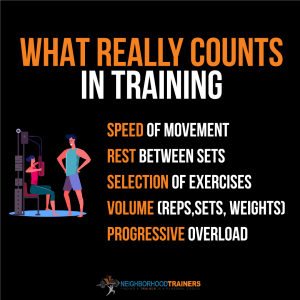March 25, 2022
 What Is Important In Creating A Training Program
What Is Important In Creating A Training Program
To be successful in almost anything in life, proper planning is required. Failure to plan is planning to fail in most cases. With exercise, when a specific fitness goal is targeted, a sound plan is definitely required for achievement. For example, let’s say your goal is to build muscle and gain strength. Several factors will need to be considered when creating an exercise program to allow you to efficiently add muscle mass. You can do your own, sound research or consult with a personal trainer to build your exercise plan. Either way, make sure it addresses the following: speed of movement, proper rest, exercise selection, volume, and overload progression.
Speed of Movement
Strength training is not a race. The goal is not to move the weight from point A to point B as quickly as possible. Movement in strength training is about controlling the movement of the weight. Usually this means a somewhat slow, or smooth, controlled motion whereby proper form is used to move the weight from the start position to the desired finish.
For example, with a bicep curl, the idea is not to swing the weight quickly out in front of you. This creates a jerky, convulsive movement until it reaches the top, which is then quickly pulled back down to the start. Rather, a smooth controlled arc from bottom to top, slow stop, and then a smooth arc to return to the start. Many exercisers employ a count of 3 or 5 during each phase of the movement.
Rest Between Sets
Just as sleep is important to our overall performance, rest in between sets has an impact on our exercise performance. This promotes muscle repair and recovery. The optimal amount of rest between sets for muscle growth can be anywhere from 30 to 90 seconds. It all depends upon goals and exercises being performed. In some more extreme endurance cases, you may opt for 30 second or less rest periods. The optimal rest period should be determined beforehand, so it can be adhered to during exercise. It is important to help replenish glycogen and oxygen stores. Discuss this with your personal trainer.
Exercise Selection
This is the most obvious part of any exercise routine. Most people decide that day, or even while exercising what exercises they are going to do. That shows a lack of planning. They may improve their overall fitness level, simply because they are exercising, but if there is a solid, specific fitness goal in mind, it is less likely to be achieved. Planning out exercises based on goals is paramount. Selecting the order of exercises is important, too. Beginning with the primary muscles first and working our way towards targeting the secondary ones. The goal is to not fatigue the smaller muscles first. Doing so could affect exercise performance when performing the larger movements.
Volume (Reps, Sets, Weights)
You can’t overlook exercise volume either. This relates to the overall number of sets, reps and weight you’ll be doing. Heavier weights with fewer reps is best for powerlifters. Most exercisers look to do sets of 10-12 reps for muscle hypertrophy. Those last 2-3 repetitions are when the muscles are fatigued.
Progressive Overload
When adding muscle mass, you simply cannot use the same amount of weight every time. Adding weight puts new, additional stress on the muscle, leading to muscle growth. Muscles tear during exercise. At rest, new muscle fibers grow to help repair the muscle. This leads to hypertrophy. This progressive overload is the catalyst. If continued overload is not possible, a change in exercise selection may be necessary.












